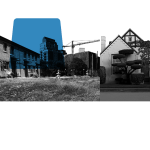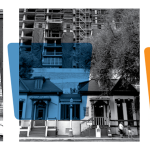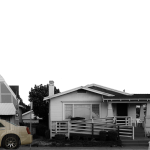The Sisters of Bon Secours came to West Baltimore in 1881 with a mission of providing “good help.” Since the beginning, this principle has pushed them to design programs and services that addressed the specific needs of the people they served. Their services have ranged from providing medical care to the poor in their homes, to operating a child care center for the first half of the 20th century, to running a hospital for the last hundred years.
In the early 1990s, the combined forces of disinvestment and the crack epidemic tested Bon Secours Hospital. These forces began to negatively affect the West Baltimore community and prevent our hospital from carrying out its mission.
Due to population loss across Baltimore and a fear of crime in our neighborhood, patient volumes declined. The loss of patients threatened to close the hospital’s doors. We recognized that we needed to redevelop the vacant properties around the hospital to bring stability to the neighborhood, making it safer for residents, patients, and hospital employees.
Beyond Bon Secours’ financial struggles, our neighbors were in crisis. At the hospital, we came to understand that our community’s health and well-being required much more than standard medical care. It became apparent that the hospital would need to rethink how we served West Baltimore residents.
We needed to operationalize the principles of community engagement that, while easy to express, were difficult to carry out.
We needed to respond to a wider set of needs expressed by residents of the community. To do this, we had to become familiar with perspectives and techniques that, at the time, were more familiar to community organizers than health care practitioners. This process involved learning a new vocabulary — terms like “asset-based” and “leverage” — and building capacity for both ourselves and those we serve.
We needed to operationalize the principles of community engagement that, while easy to express, were difficult to carry out. We needed to abandon preconceptions and learn how to listen. We needed to process the needs and desires of West Baltimore residents, who we looked to for direction and support.
Our conversations uncovered opportunities for the hospital to intervene outside the traditional boundaries of health care. With our neighborhood partners, we could address local priorities around housing, economic development, public safety, and education.
When we resisted the tug of “business as usual” and really listened, the power of sound community engagement emerged. Although the technical knowledge and capacity of Bon Secours and our partners helped move projects forward, it was the strength of community voice and involvement in planning and implementation that made success possible.
By the mid-1990s, Bon Secours had formed Unity Properties. We purchased 31 row homes and bought a vacant school from the archdiocese. We renovated the homes and turned the school into a community support center. Our primary partner, the resident coalition, grew into a formal organization, Operation ReachOut Southwest (ORSW). For its first few years as a redevelopment institution, the hospital worked without any city support. But eventually, Baltimore used funding from the US Department of Housing & Urban Development to support renovations and became a member of ORSW.
Our approach to community engagement became more refined as we worked with ORSW to create the vision and roadmap for Bon Secours Community Works. Community Works evolved to meet the changing needs of our neighbors, and now it provides early childhood development programs, financial education and support, workforce development, open space management, and reentry and youth development services. It was within this context that we were truly able to see the energy and passion that drives resident-led initiatives.
Ultimately, what our experience illustrates is that designing a hospital’s programs must be done within the context of the hospital’s community.
Today, more than 2,500 West Baltimore residents participate annually in our Community Works programs. While we still provide standard health care at the hospital, our Community Works programs are developed specifically with West Baltimore in mind.
A combination of changes to the health care industry across the country, along with our community-based work, has transformed our service model. For example, while we’ve reduced the number of licensed hospital beds to less than 80, we’ve expanded our housing portfolio to nearly 800 units.
Ultimately, what our experience illustrates is that designing a hospital’s programs must be done within the context of the hospital’s community. There is no one-size-fits-all approach — no method that can reasonably justify bypassing community engagement or disregard the essential role of residents in achieving success.
Fortunately, community engagement is increasingly becoming a central feature in many hospitals’ work. For instance, nonprofit hospitals across the country are now required to conduct community health needs assessments.
Here in Maryland, we have the opportunity to collaborate with residents and partners around workforce development for a statewide initiative called the Health Enterprise Zones. Even within our own hospital, we have a system-wide effort, the Healthy Community Initiative, to help focus our community benefits projects. These kinds of tools help hospitals like Bon Secours partner with residents to tailor services to meet the needs of the community.
Moving forward, we see an opportunity for our community to continue to play an active role in Bon Secours’ efforts. In fact, we’ll look to them to lead the way. We do not believe we have all the answers to the pressing health issues of the day, nor do we pretend to know what community development projects other hospitals should take on.
What we do know is sound and effective community engagement will enable willing hospitals and organizations to connect in new and more meaningful ways with their communities. It’s an approach that will lead to high-quality and innovative interventions, desired outcomes, and strong relationships between institutions and their neighbors.
George Kleb is the executive director of Housing & Community Development at Bon Secours Baltimore Health System


